OCR bank statements to Excel
Extract data from OCR bank statements to Excel. Automate processing, save time, and convert bank statements accurately into organized Excel spreadsheets.
Add Your File
Drag & Drop Or Select File
Data security is our top priority
Bank Statement Converters prioritises the confidentiality and integrity of your data. As a testament to our commitment, we adhere to stringent compliance standards, including GDPR, SOC 2, and HIPAA. Privacy Policy



How to Convert OCR Bank Statements to Excel Online
Why Choose OCR bank statements to Excel?
Accessibility
Bank Statement Converter offers an easy-to-use platform, allowing you to upload files and download Excel sheets anytime, anywhere without technical skills.
Affordable Plans for Everyone
Affordable Plans for Everyone tailored to meet diverse needs without breaking the bank, offering flexibility and value for all.
Starter
$90 / month
Save 10% annually
Why should you take this
4,800 pages per year
PDF Bank Statement to Excel
PDF Bank Statement to CSV
Convert Password Protected Statement
Multiple PDFs to a Single CSV
Global Banks Supported
Get Started
Professional
$180 / month
Save 20% annually
Why should you take this
12,000 pages per year
PDF Bank Statement to Excel
PDF Bank Statement to CSV
Convert Password Protected Statement
Multiple PDFs to a Single CSV
Global Banks Supported
Get Started
Business
$360 / month
Save 20% annually
Why should you take this
48,000 pages per year
PDF Bank Statement to Excel
PDF Bank Statement to CSV
Convert Password Protected Statement
Multiple PDFs to a Single CSV
Global Banks Supported
Get Started
Most Popular
Enterprise
$Custom / month
Save 20% annually
Why should you take this
PDF Bank Statement to Excel
PDF Bank Statement to CSV
Convert Password-Protected Statement
Multiple PDFs to a Single CSV
Global Banks Supported
Get Started
OCR Bank Statements to Excel Conversion: Tool vs. Manual Process — What’s Better?
Features
OCR Bank Statement To Excel Converter
Manual Process
Auto data extraction
Time saving
Reduces human error
Batch processing support
Extracts tables accurately
Supports CSV and Excel output
Handles scanned or image PDFs
Preserves row and column structure
No need for manual formatting
Works with multiple file types
Frequently Asked Questions
Can OCR convert scanned bank statements directly into Excel sheets?
What file formats of bank statements can OCR process?
Can OCR extract specific data fields from bank statements?
Tired of wasting hours copying data from bank statements? One small error can ruin your entire report. Scanned files, blurry images, or complex tables make the job harder. That’s where OCR bank statements to Excel helps—extracting data and converting statements directly into clean, editable sheets.
Still, not every tool gets it right. Poor formatting, missed transactions, or errors often happen without the right OCR.
Here, you’ll find everything you need—key benefits, major challenges, and what features to look for. This guide helps you process bank statements faster and avoid costly mistakes.
What Is an OCR Bank Statement?
OCR is a technology that scans printed or scanned bank statements, extracts transaction data, and converts it into digital formats like Excel or CSV. It reduces manual data entry, saves time, and helps organize financial information easily.
Optical Character Recognition (OCR), helps you pull important data from your bank statements automatically. Instead of typing every transaction, OCR reads the scanned or digital statement and captures transaction dates, descriptions, and amounts in a structured digital format. This removes the hassle of manual work.
Once the data is extracted, you can easily transfer it into Excel or financial software for further use. This makes financial tracking, reporting, and auditing much faster. As a result, OCR technology improves accuracy, minimizes errors, and keeps your financial data organized for easy access.
What are the Advantages of OCR Bank Statement to Excel Conversion?
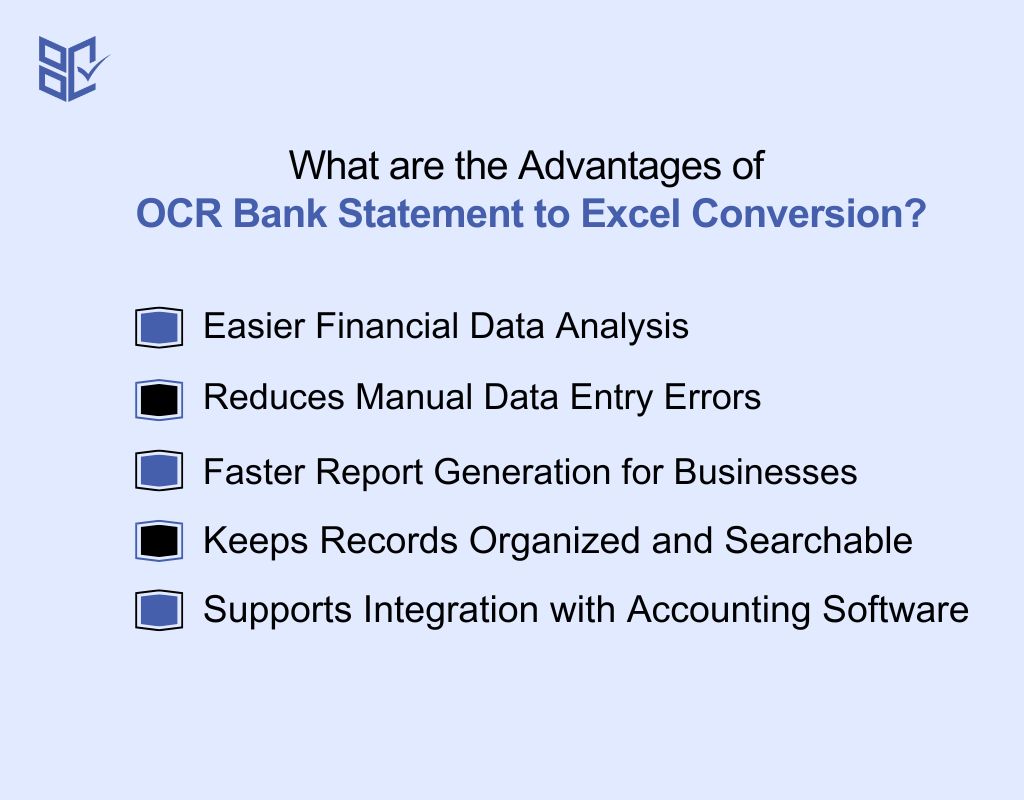
Converting OCR bank statements to Excel helps you handle your financial data efficiently. It saves time, avoids manual errors, and allows easy analysis and reporting. Below are important reasons why you should consider this process:
Easier Financial Data Analysis
Once your bank statement is in Excel, you can filter, sort, and calculate totals easily. It helps you understand spending patterns, track transactions, and manage budgets better without spending hours checking statements manually.
Reduces Manual Data Entry Errors
Manually typing bank data often causes mistakes. By converting OCR bank statements to Excel, you avoid these errors. It ensures your records stay accurate, saving you time correcting data or facing issues during audits or financial reviews.
Faster Report Generation for Businesses
You generate financial reports faster when your bank data is in Excel. It allows you to create profit and loss statements, cash flow reports, and transaction summaries quickly, supporting business decisions and simplifying financial tracking every month.
Keeps Records Organized and Searchable
Excel organizes your bank statement data neatly in rows and columns. You search transactions by amount, date, or description instantly. It saves time, especially when you need to find specific payments or check financial records during tax season.
Supports Integration with Accounting Software
Once converted to Excel, your bank statement data integrates easily with accounting tools. You import it into software like QuickBooks or Xero, making bookkeeping smooth and helping you avoid duplicate entries or missing financial details.
How Does an OCR Bank Statement to Excel Converter Work?
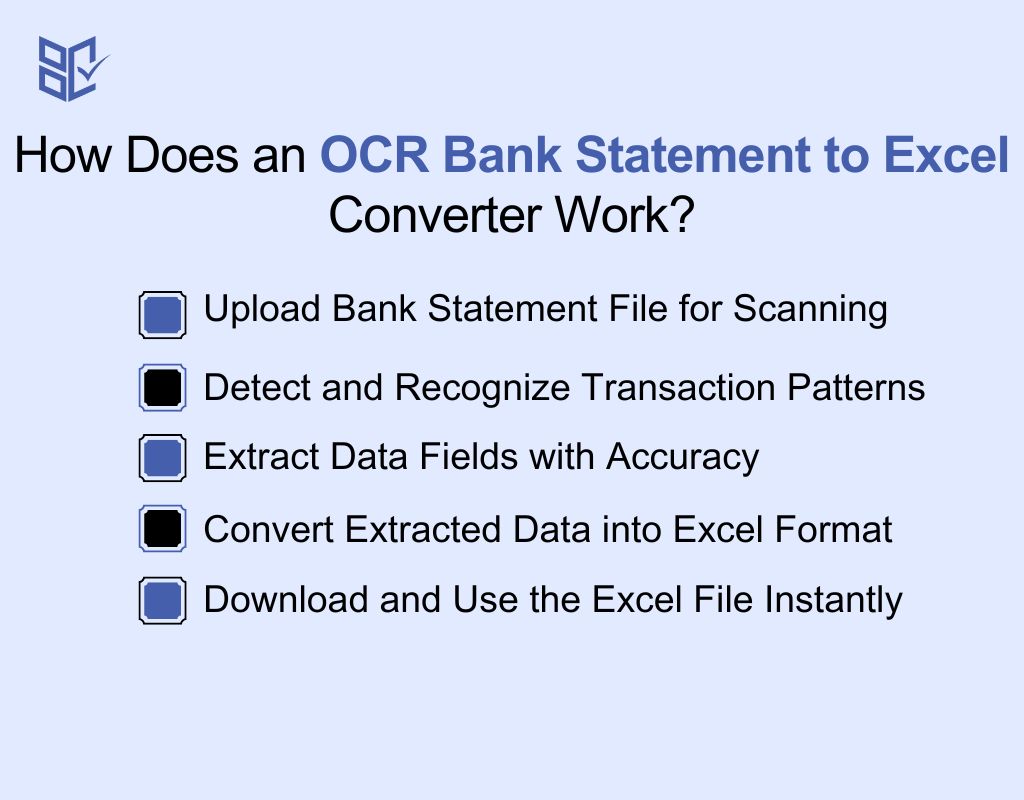
OCR converters help you process bank statements Pdf to Excel quickly. You upload your file, the tool scans the content, extracts transaction data, and creates a clean Excel sheet ready for use.
Upload Bank Statement File for Scanning
Upload your bank statement in PDF, image, or scanned format. The converter identifies the document’s layout, including tables, rows, and data fields. No manual setup or templates are needed, making the start simple and accessible for any user.
Detect and Recognize Transaction Patterns
The tool scans your document to detect transactions. It identifies repeating patterns like dates, descriptions, and amounts while ignoring unnecessary text. This helps capture only the financial data you need for reports or bookkeeping tasks, avoiding irrelevant document sections.
Extract Data Fields with Accuracy
OCR extracts important data points like transaction date, description, debit, credit, and balance. The system ensures accuracy, reducing errors common in manual entry. Even complex tables with merged cells or inconsistent formats get processed into structured data automatically.
Convert Extracted Data into Excel Format
After extraction, the tool converts the data into an Excel file. It keeps proper alignment, columns, and structure so your financial records stay clear. You can edit, sort, or filter the data without fixing formatting issues manually.
Download and Use the Excel File Instantly
Download your converted Excel sheet instantly. It’s ready for financial analysis, reporting, or importing into accounting software. This saves time, ensures data accuracy, and gives you full control over your financial records without technical knowledge.
Benefits of Converting Bank Statements to Excel Using OCR
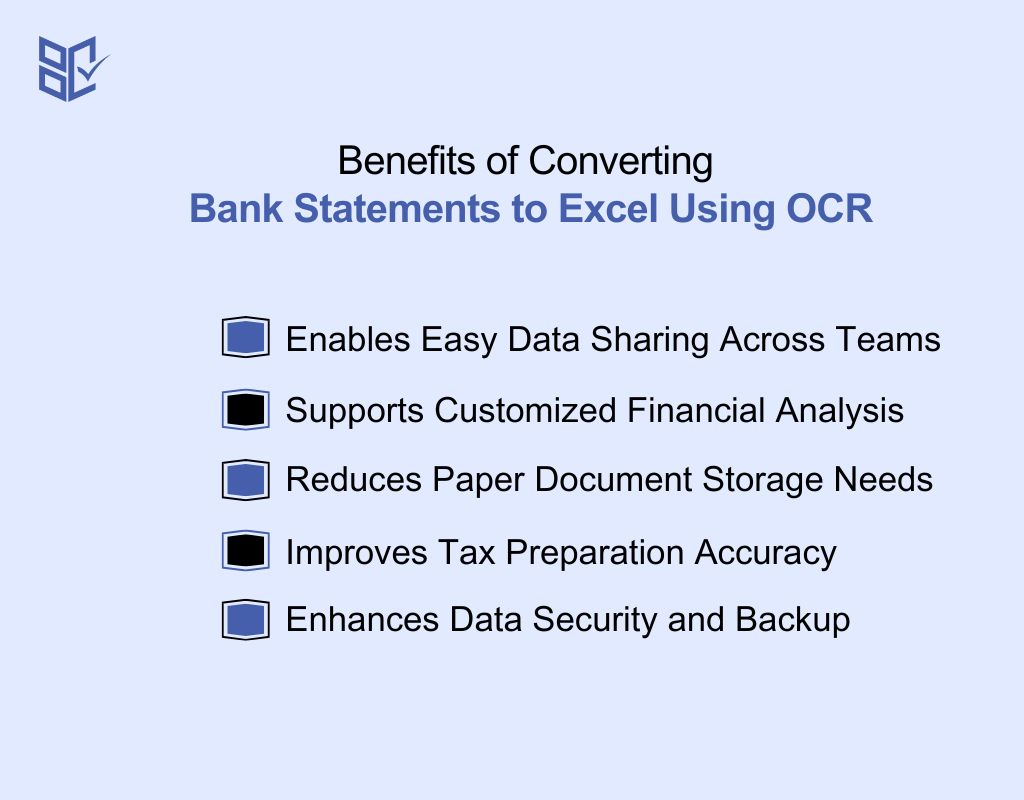
Converting bank statements with OCR saves time and keeps your data organized. It reduces manual work, improves accuracy, and simplifies financial tracking for individuals or businesses. Here are the key benefits you enjoy:
Enables Easy Data Sharing Across Teams
You share Excel files easily with team members, accountants, or auditors. It improves collaboration during financial reviews, making sure everyone accesses the same organized data without handling paper statements or scanned documents.
Supports Customized Financial Analysis
Once in Excel, you apply formulas or create charts to analyze spending patterns. This helps you monitor cash flow, identify cost-saving opportunities, and make better financial decisions based on real transaction data.
Reduces Paper Document Storage Needs
Converting statements to Excel reduces your need for physical storage space. You keep digital records organized, avoid losing important documents, and access financial data anytime without digging through paper files.
Improves Tax Preparation Accuracy
Accurate Excel data simplifies tax filing. You pull required transactions quickly, verify income or expenses easily, and reduce the risk of missing deductible items during tax preparation or audits.
Enhances Data Security and Backup
Digital Excel files are easier to back up than paper statements. You store them securely in cloud storage or drives, preventing data loss and ensuring quick recovery if needed.
Common Use Cases of Bank Statements to Excel Using OCR
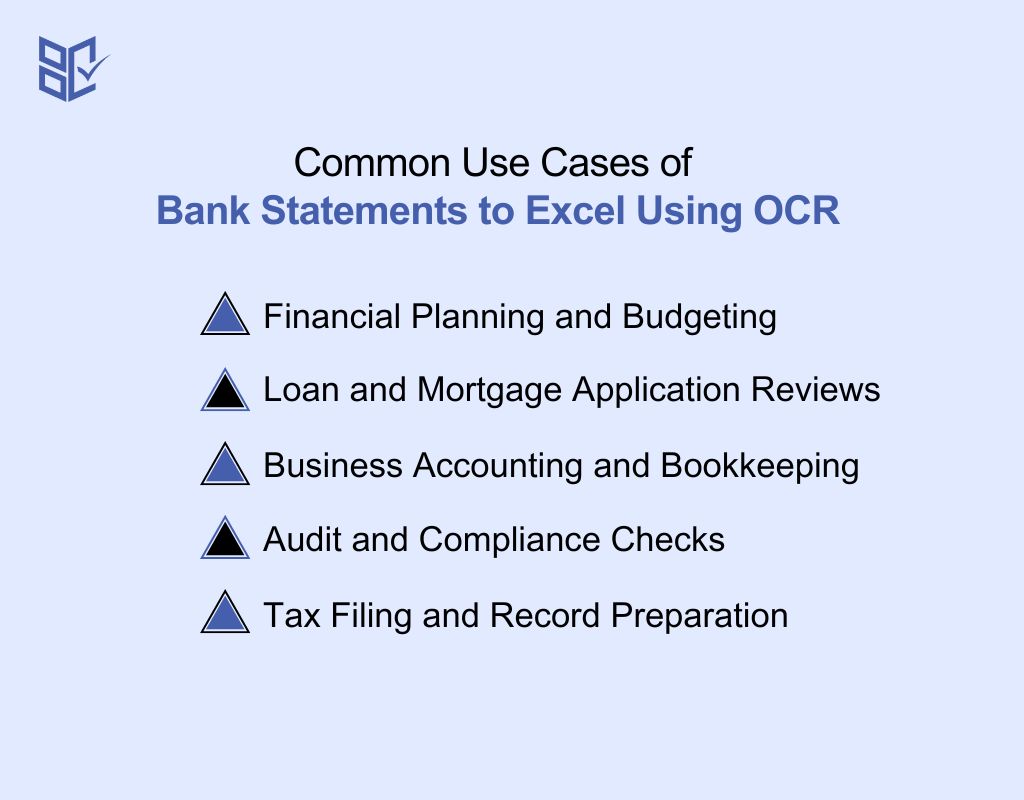
Converting bank statements to Excel using OCR helps in various real-world tasks. It simplifies financial management, saves time, and improves data accuracy across personal, business, and professional needs.
Financial Planning and Budgeting
You organize your income and expenses easily in Excel. It helps you track spending patterns, set budgets, and monitor savings goals accurately without missing transactions or struggling with messy paper statements.
Loan and Mortgage Application Reviews
OCR conversion makes gathering financial data simple for loan processing. You provide clear Excel sheets to lenders, helping them verify your income, expenses, and creditworthiness faster during mortgage or loan applications.
Business Accounting and Bookkeeping
Businesses convert bank statements for accurate bookkeeping. It simplifies expense tracking, prepares data for accounting software, and supports monthly financial reporting without errors or wasting hours entering transaction details manually.
Audit and Compliance Checks
Auditors need clear financial records. OCR conversion ensures transactions are well-organized in Excel. Thus making audits smoother and helping you meet compliance standards by providing clean, verifiable financial data quickly when required.
Tax Filing and Record Preparation
Tax season becomes easier with Excel data. You access all transactions, verify deductible expenses, and generate reports needed for tax filing. It reduces missed entries and ensures your financial records stay audit-ready.
Choosing the Right OCR Software for Bank Statement Conversion
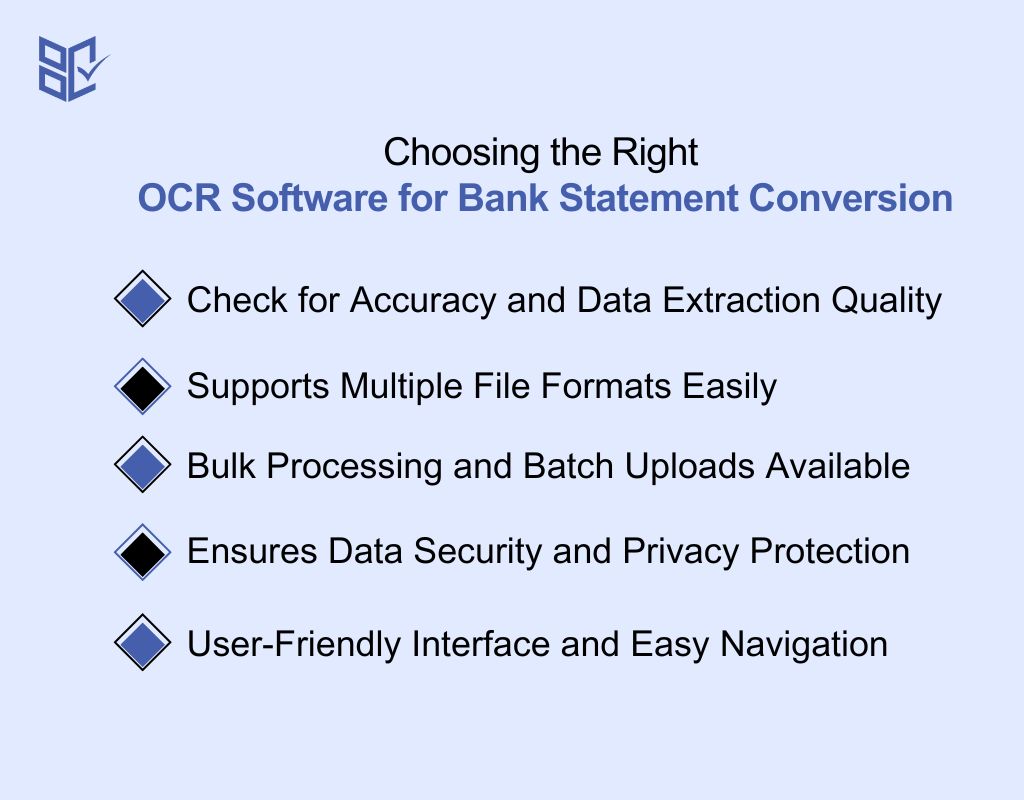
Picking the right OCR software ensures accurate data extraction and smooth processing. Look for features that match your financial needs and handle bank statements efficiently.
Check for Accuracy and Data Extraction Quality
Choose OCR software that reads complex tables accurately. It should extract dates, descriptions, and amounts without errors, maintaining the statement’s structure and helping you avoid manual corrections later.
Supports Multiple File Formats Easily
Select software that handles PDFs, images, and scanned files. It saves you time converting formats manually and ensures smooth processing of all types of bank statements for reliable results.
Bulk Processing and Batch Uploads Available
If you handle multiple statements, pick a tool supporting bulk uploads. This helps you process large volumes of statements quickly, improving efficiency and avoiding repetitive, time-consuming manual tasks.
Ensures Data Security and Privacy Protection
Make sure the software protects sensitive financial data. It should follow security protocols, delete files after processing, and prevent unauthorized access to your uploaded bank statements.
User-Friendly Interface and Easy Navigation
Choose a tool designed for easy use without technical skills. A simple interface helps you upload files, select output formats, and download the Excel sheet easily, saving time and reducing errors.
Best Tools To Convert OCR Bank Statements to Excel Free
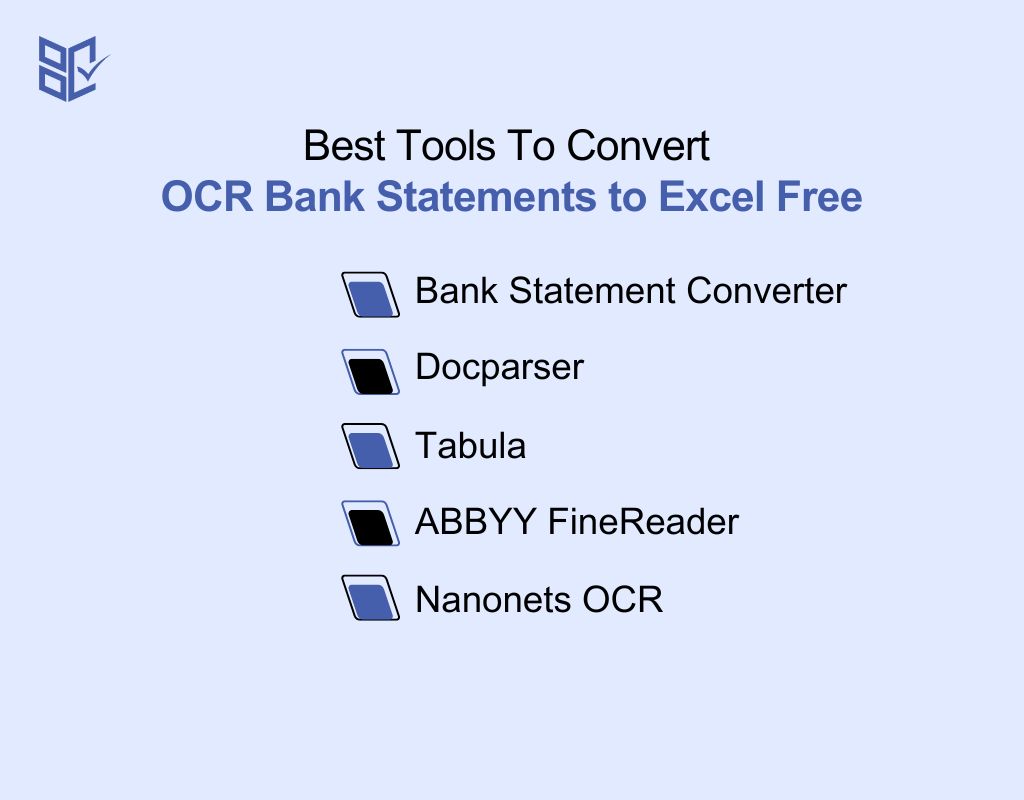
Managing financial data from bank statements requires reliable OCR tools built for accuracy. Below are the top tools designed to convert complex bank statements into clean, structured Excel files effortlessly:
Bank Statement Converter
Free Bank Statement Converter specializes in processing bank statements. It handles PDFs, images, and scanned files, accurately extracting transaction data into Excel or CSV formats. With no software installation needed, it offers simple, secure, and fast conversion—perfect for businesses or individuals managing regular financial data.
Docparser
Docparser allows you to set custom parsing rules to extract specific data from bank statements. It processes PDFs, scanned documents, and images while delivering structured Excel output. Ideal for businesses, it also offers batch processing and seamless integration with other financial or automation tools.
Tabula
Tabula is a free, open-source tool designed for extracting data from tables in PDF bank statements. It works best with digital PDFs and provides clean CSV or Excel outputs. Though simple, it’s effective for users needing occasional data extraction without complex software.
ABBYY FineReader
ABBYY FineReader is a powerful OCR software known for handling complex scanned documents. It reads detailed bank statements, accurately extracting data into Excel. It supports batch processing, multiple formats, and delivers high accuracy, making it ideal for large businesses needing reliable OCR solutions.
Nanonets OCR
Nanonets OCR offers AI-driven data extraction, automatically detecting key fields in bank statements. It supports API integration, bulk uploads, and custom model training. This tool is perfect for businesses requiring automated workflows and fast processing of large volumes of financial documents into Excel.
Conclusion
Converting OCR bank statements to Excel makes your financial tasks easier, faster, and more accurate. Instead of struggling with manual entry or messy statements, you get clean, ready-to-use data. Still, choosing the right tool matters to avoid errors or missing details.
With the right OCR solution, you save time, improve accuracy, and keep your records organized. It’s a smart way to handle complex financial data effortlessly. Start using OCR today and simplify your bank statement processing without worrying about mistakes slowing you down.